Dell XPS 13 Review
by Brett Howse on February 19, 2015 9:00 AM EST- Posted in
- Laptops
- Dell
- Ultrabook
- Broadwell-U
- XPS 13
System Performance
The XPS 13 is our first look at a notebook with Broadwell-U, which was launched concurrently with this and several other laptops at CES. For a complete look at the launch, check out Ian’s coverage here. The big changes with Broadwell-U over Haswell-U are two things.
First, Intel has moved to the 14nm process, refining their 3D FinFET design. This brings a lot of advantages in terms of power consumption. This is what is called a “Tick” on the Intel Tick-Tock roadmap. Ticks are die-shrinks of the previous “Tock”, which is an architecture update, in this case Haswell. Because this is basically the same CPU architecture, performance gains will be secondary to the reduction in power consumption.
Second, contrary to the CPU architecture, Intel has been iterating the GPU on every new processor. On the 15 watt Core parts, this change results in more execution units (EUs) per GPU, with the HD5500 in the XPS 13 having 23 EUs on the Core i3 model and 24 on the Core i5 and i7. The outgoing Haswell parts had only 20 EUs. This should give a slight bump in GPU power over Haswell, and there may be some other minor differences in the GPUs.
Performance Graphs
For our performance workloads, we set the device to High Performance and then run through some benchmarks to cover a wide range of workloads. For comparison, I will graph it against several of last year’s Haswell-U parts, the Atom based HP Stream 11, and the Dell XPS 15, which has a higher wattage quad-core CPU and discrete GPU. If you would like to compare it against any other device we have tested, please use our online database, Bench.
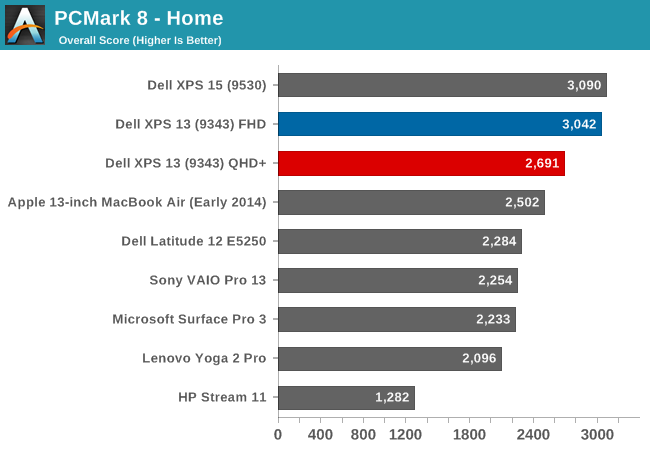
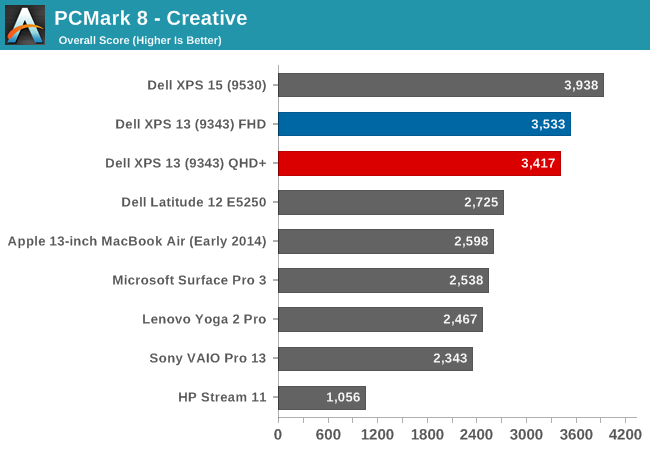
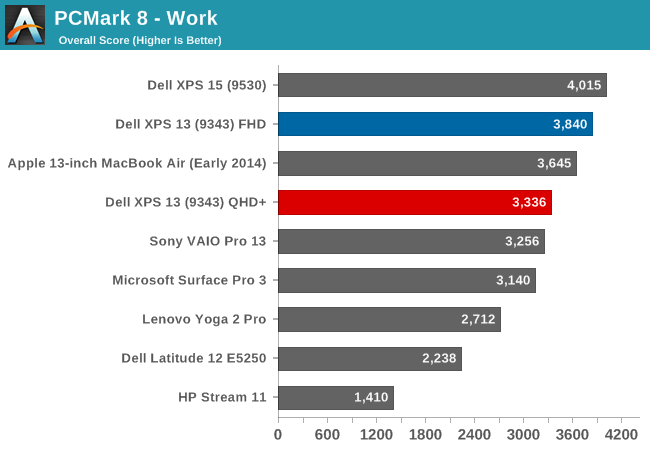
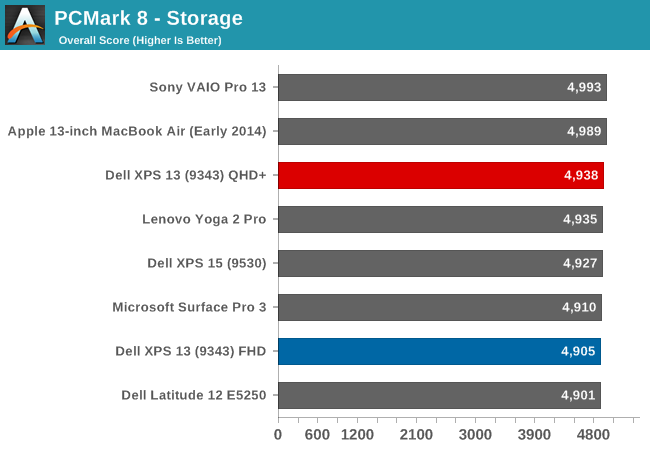
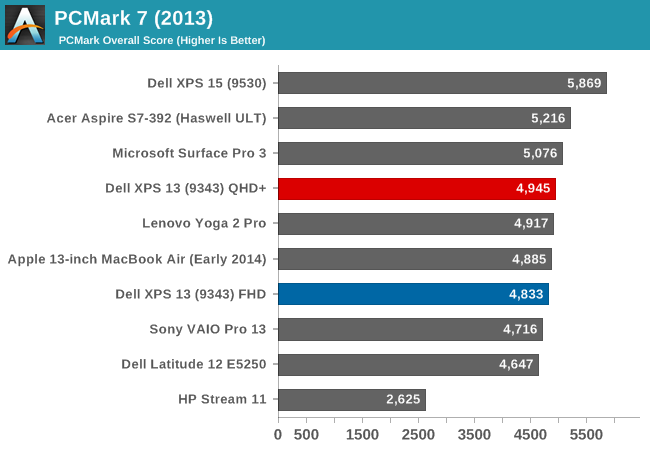
PCMark 8 from Futuremark runs through a variety of tests, and many of the test feature OpenCL support. The Home benchmark runs through what the typical home user would do: web browsing, gaming, and photo editing. Creative is for media and entertainment creation and is more demanding than the Home test. The Work suite tests basic office tasks. The higher resolution model has more work to do on these and scores a bit behind the 1080p model, but overall the new XPS 13 scores quite well on these types of workloads.
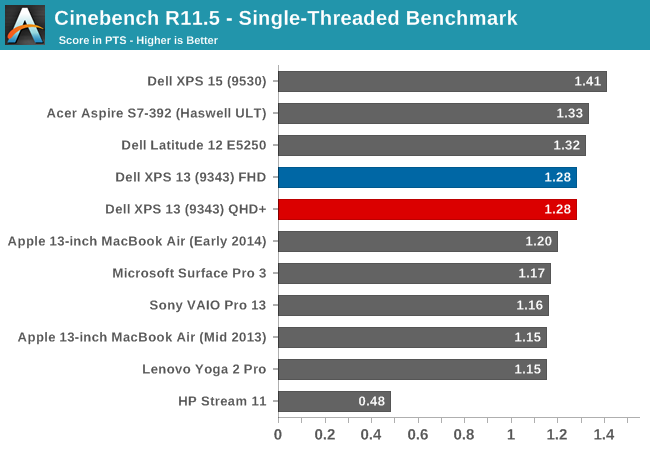

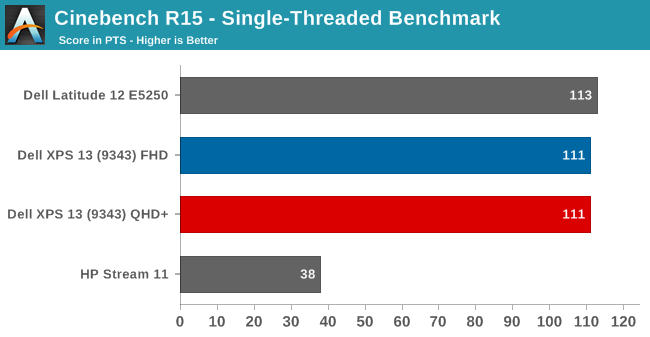
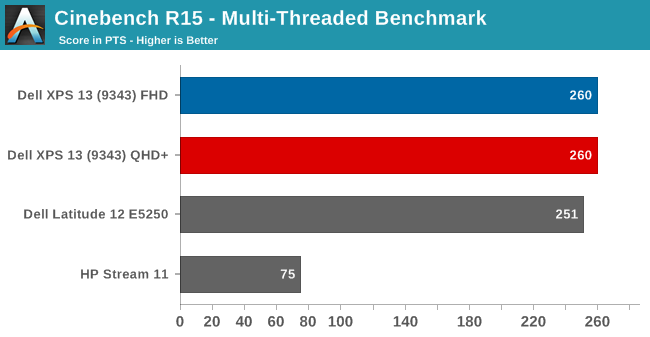
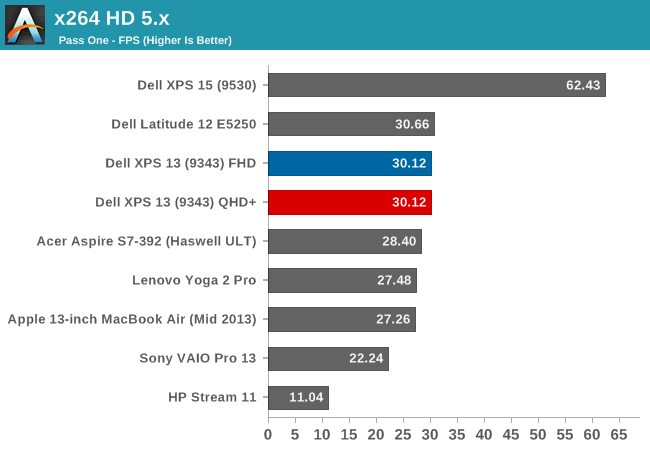
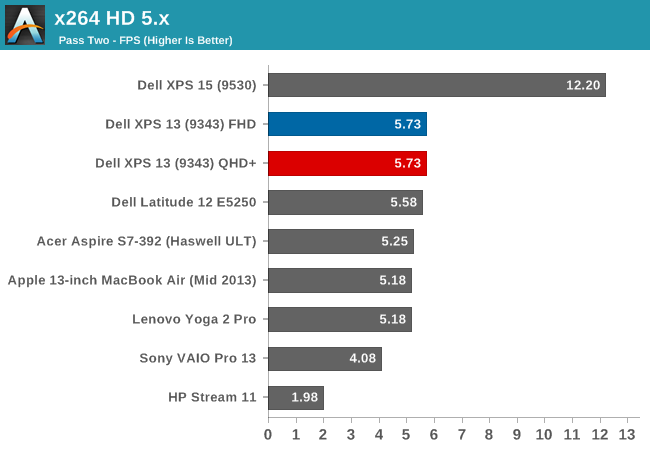
Cinebench tests the CPU's ability to render a scene. Broadwell-U does well here, and though the single core scores show that the i5-5200U is a bit slower than the Acer's i7, and especially the XPS 15 with it's higher TDP part, there is a nice bump up from the i5-4200U in the Lenovo Yoga 2 Pro. Multithreaded is where the new 14nm process can really shine. The lower power usage means that there is more headroom for the CPU to keep the clock speeds higher when all cores are active, and it shows a great result here compared to the Haswell-U series parts. x264 HD also shows favorable results for Broadwell, with the i5-5200U outperforming the old i7-4500U. The Dell XPS 15, with the full quad-core, eight-thread CPU, unsurprisingly outperforms all of the U series CPUs.
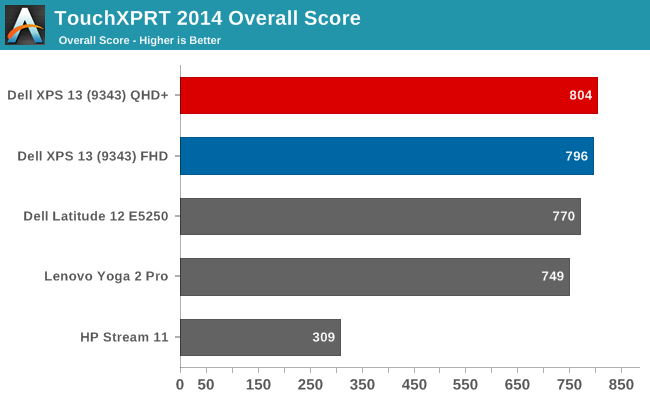
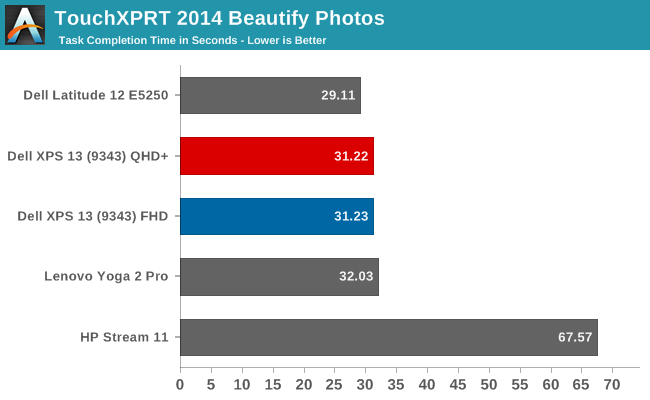
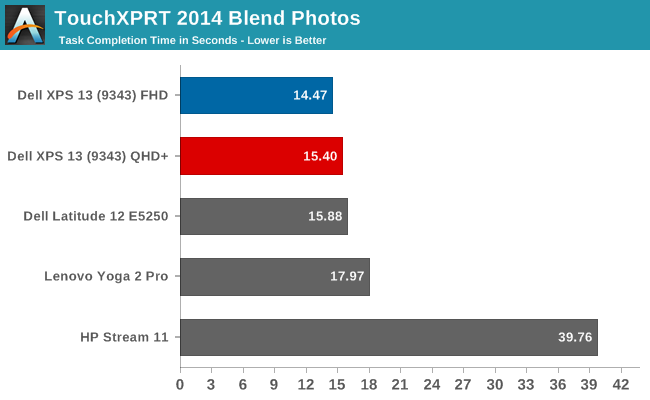
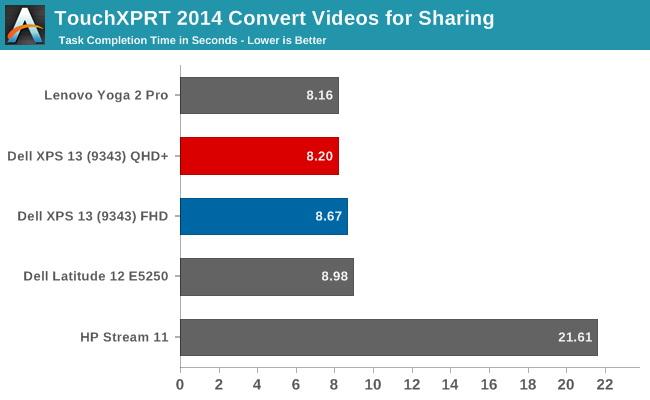
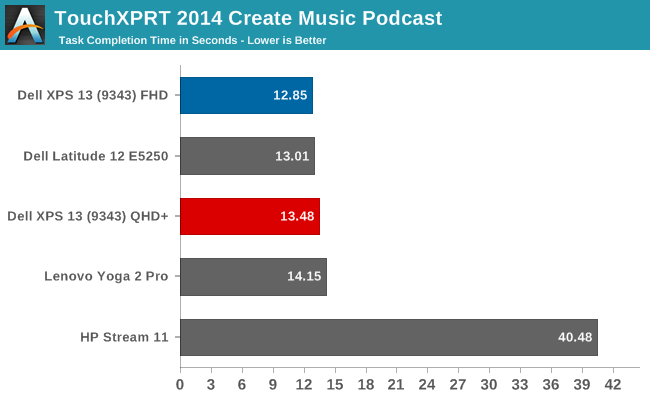

TouchXPRT 2014 is a WinRT app found in the Windows App Store that performs a series of common tasks for a typical home user, and calculates a score based on how quickly the tasks were performed. Here Broadwell seems to perform very similarly to Haswell, with the exception of the video conversion which was quite a bit slower. Update 2015-02-20: Intel has provided us with an updated graphics driver which solves the slow video conversion issue. I have re-run the tests and updated the graphs. If you would like to install this driver from Intel.com, you must first remove the existing one from Programs and Features or you will be blocked from installing, since the version that comes with the device is from Dell.
The Yoga 2 Pro has the Core i5-4200U, and the Dell XPS 13 is the Core i5-5200U, so it makes a good comparison for performance. Overall, the Broadwell based XPS 13 is generally slightly faster than the previous generation processors, but not by much for most single cpu tasks. Multithreaded scenarios show a nice gain in performance with Broadwell just from the ability to keep the clock speeds higher under heavily threaded loads.
As expected, the switch to 14nm did not bring a huge performance change for the CPU, and for that we may have to wait for Skylake, which is the next Tock from Intel (new processor architecture) coming later this year. The Dell XPS 15, with its higher wattage quad-core CPU, shows a clear lead as expected, and the Atom processor in the HP Stream 11 is sorely outclassed.
Interestingly, the FHD model was able to outperform the QHD+ model on a couple of the PCMark 8 tests. I’ve re-ran the benchmarks several times, and these results are consistent. The PCMark tests do include some gaming and other GPU loads which would be slower on the high DPI display.
WiFi
The review units we received both came with the Dell Wireless AC 1560 adapter, which is based on a Broadcom chipset. Originally I had connection issues on 5 GHz with the QHD+ model, but Dell shipped out a driver update which seems to have sorted that, so if you have purchased one of the early model XPS 13s, check Dell’s site for some updates.
Optionally, Dell will outfit the XPS 13 with the Intel Dual Band Wireless-AC 7265 adapter, or the spec sheet also lists the Wireless-N version of this Intel adapter. I have seen and used the AC 7265 on a couple of machines, such as the Dell Latitude 12 E5250, and it performed very well.
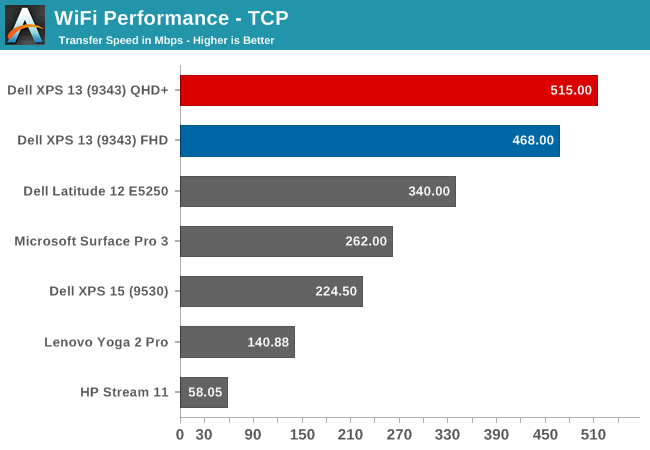
Wireless performance was very good, with the Broadcom chip pulling to the top of the chart. Once the initial connection issues were resolved with the driver update, I had no problems with the wireless connection on the XPS 13.










201 Comments
View All Comments
Stochastic - Thursday, February 19, 2015 - link
I’ve been using this machine for a few weeks now. My impressions so far are largely positive. Here are some things that would take this laptop from “Great” to “Unbeatable”:--Offer option to disable auto-brightness
--Improve display calibration of FHD model
--Use less aggressive anti-glare coating on FHD model
--Give more touchpad options for configuration
--Reduce tendency of fan to spool up when plugged in (this can be tweaked in software settings, however)
--Adjust position of webcam
--Add just a smidge more key travel (I wouldn’t mind a 1mm thicker device)
--Use a different material for keyboard such that smudging is less noticeable
--Reduce price of 256GB SSD/8GB RAM model by $100
--Provide option for touch display on the FHD model for $100 or less premium
If Dell made the above changes then this device would absolutely take the market by storm. As is, it’s still a very solid device in my opinion.
I will say that I’m not getting anywhere close to the battery life that Anandtech is reporting for the FHD model. I’ve read on forums that the CPU usage spikes up whenever the touchpad is used, so that might account for the disparity. It would be great if Anandtech could investigate this.
eddman - Thursday, February 19, 2015 - link
"I will say that I’m not getting anywhere close to the battery life that Anandtech is reporting for the FHD model."Do you mean web browsing battery life? If so, are you using chrome? If yes, then it could be the culprit. Last time I checked chrome used a bit too much power compared to IE.
Stochastic - Thursday, February 19, 2015 - link
Yeah, I am using Chrome. I feel crazy saying this, but I'm actually really looking forward to Microsoft's Spartan browser.ymcpa - Thursday, February 19, 2015 - link
Why would you say you feel crazy? IE has been a good browser for a while now and it is less resource intensive than chrome. It's funny that chrome started out as the light, simple alternative to IE and now it is the bloated one. The only reason to stay with chrome is if extensions are important to you and Spartan is reported to allow extensions.CaedenV - Thursday, February 19, 2015 - link
Ya, I use to swear by chrome a few years ago, but about 1.5 years ago I started having odd issues where it would slow my computer down and have odd rendering/graphical glitches. I tried FF again for a few months but really hate the changes they have been making to it. So now I have been using IE for the last year for lack of something better... and you know what? It pretty much works. I do miss some of the plugins that I use to have, but the privacy settings do a decent job at blocking most adds which is the big thing. Not saying that I have really fallen in love with IE, but for 90% of what I do it works great, and the other 10% I hold my nose and use FireFox.If not for the performance (and privacy paranoia) I would switch back to chrome in a heartbeat, but it simply is not as good as it use to be compared to the other options available.
mhonard - Friday, March 13, 2015 - link
I have the MS signature version with i5, 256gb, 8gb ram, QHD touch display and NOT running chrome. Light usage I'm only getting 6.5 hours of usage in balanced mode. I am using the touchpad exclusively. It would be nice to understand why I'm getting such a different result than Anadtech. This is a deal killer for the price I paid.Brett Howse - Saturday, March 14, 2015 - link
Could be lots of things really. What is your display set to for brightness? Display is a big draw. You are getting between our heavy workload and our light workload, so assuming your display is close to 200 nits, it could just be that your light workload is still a lot heavier than our light web browsing workload. File copies, network access, and other things can all contribute to a lot more power draw.First suggestion is to set the brightness lower as it will likely have the biggest impact. You can also try installing Battery Bar to see what kind of power draw you are pulling at any one time.
tipoo - Thursday, February 19, 2015 - link
Go to the windows 8 start screen and just type in brightness, the auto feature should be there to turn off? I don't have this model but that's how it worked on every win8 laptop I used.ymcpa - Thursday, February 19, 2015 - link
The article stated that there is no option to off the auto brightness setting and have asked Dell to respond. I'm sure it is something that can be fixed in a future firmware update.ymcpa - Thursday, February 19, 2015 - link
Not sure what more touchpad options mean. I bet the fan spools up when plugged in because the power setting are set for highest performance when plugged in. There is probably not much they can do with the web cam without increasing the bezel. I would suggest a flip up web cam that is hidden and you flip it up when you need it. Plus this will insure privacy since people won't be able to hack in to the laptop and access the web cam. The rest of your comments seem very doable.